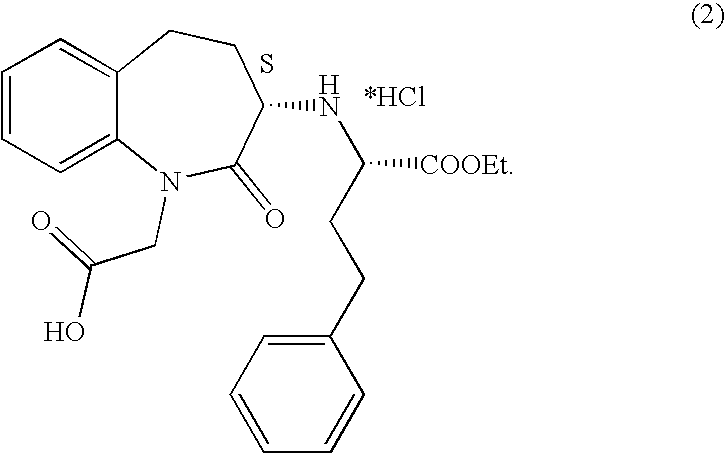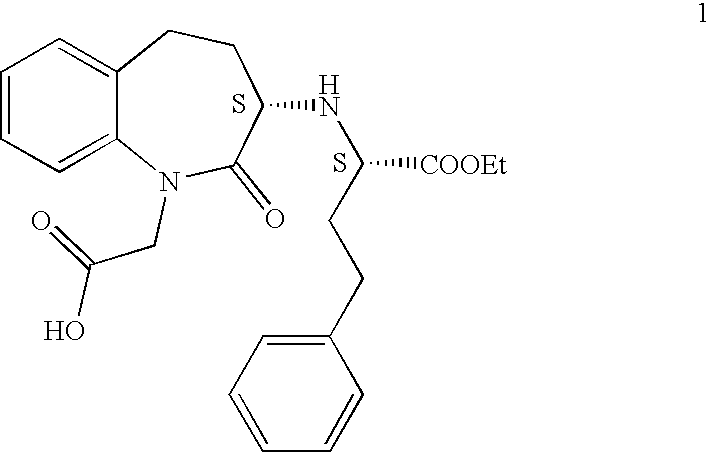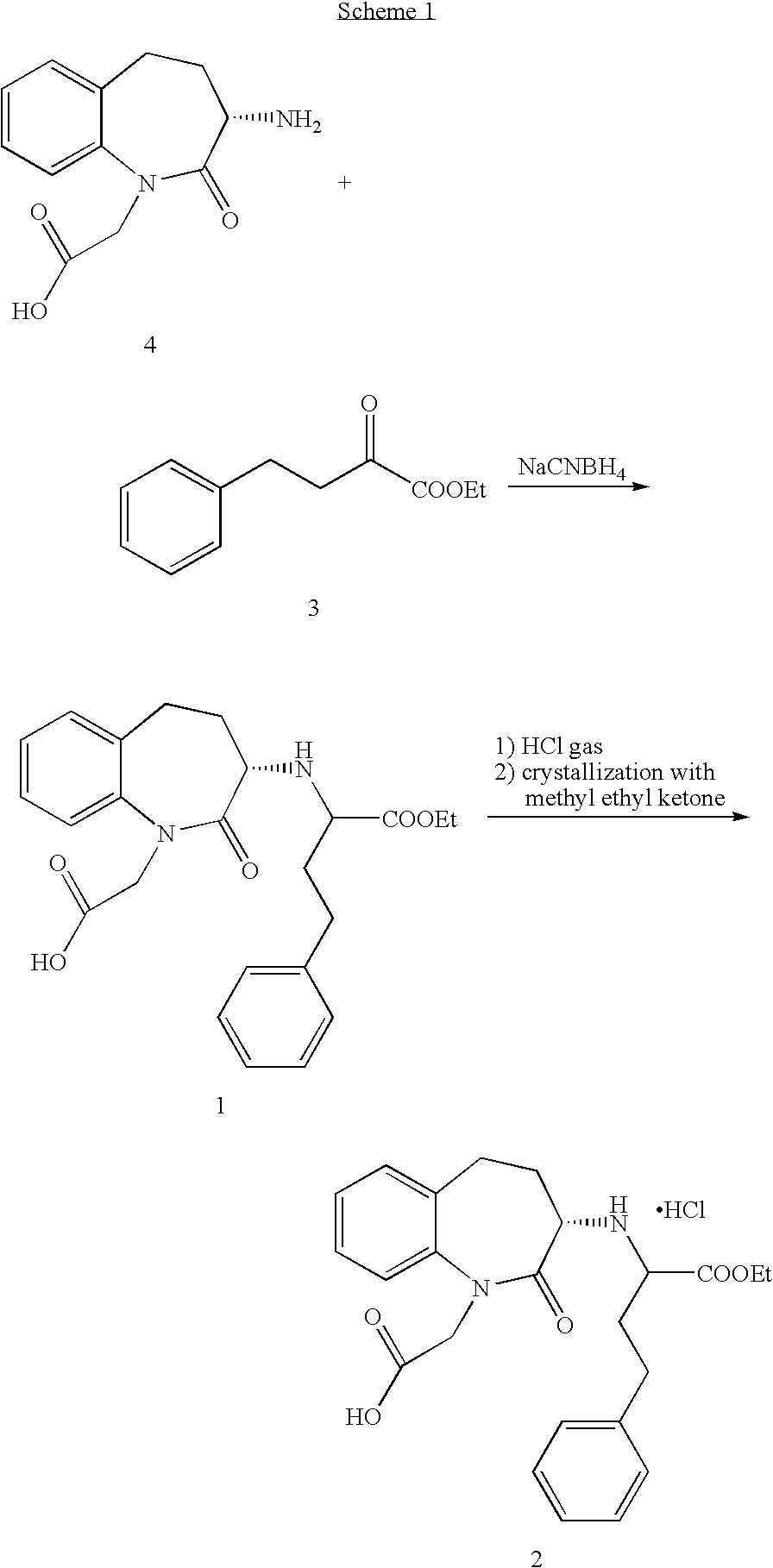Process for the preparation of benazepril hydrochloride
a technology of benazepril and hydrochloride, which is applied in the field of aceinhibitors, can solve the problems of difficult separation of diastereomeric mixtures, difficult use of precursors, and inability to obtain hydrochloride in too low diastereomeric ratios to be marketed
- Summary
- Abstract
- Description
- Claims
- Application Information
AI Technical Summary
Benefits of technology
Problems solved by technology
Method used
Image
Examples
example 1
Preparation of 3-[[1-(carboxy)-3-phenyl-propyl]amino]-1-t-butoxy-carbonylmethyl-2,3,4,5-tetrahydro-1H-benzazepin-2-one (15)
[0030]Ethyl 3-benzoylacrylate (13a) (55.6 g, 272 mmoles) is dropped into a solution of (3S)-3-amino-1-t-butoxycarbonylmethyl-2,3,4,5-tetrahydro-1H-benzazepin-2-one (11) (66.2 g, 228 mmoles) in 200 ml of ethyl acetate, at room temperature in 1 h. The resulting mixture is left under stirring for 18 h, added with 10% Pd—C (26 g, 22 mmoles) and hydrogenated at 3 atm for 18 h at room temperature. After completion of the reaction, 200 ml of acetic acid are added and the mixture is hydrogenated for a further 18 h at 3 atm and at room temperature. After this time, the catalyst is filtered off through Celite and the solvent mixture is evaporated to dryness, the residue is taken up in dichloromethane (200 ml) and the resulting precipitate is filtered, washed with 20 ml of dichloromethane and dried to give 3-[[1-(carboxy)-3-phenyl-propyl]amino]-1-t-butoxycarbonylmethyl-2,3...
example 2
Preparation of 3-[[1-(carboxy)-3-phenyl-propyl]amino]-1-t-butoxycarbonylmethyl-2,3,4,5-tetrahydro-1H-benzazepin-2-one (15)
[0032]Ethyl 3-benzoylacrylate (13a) (55.6 g, 272 mmoles) is dropped into a solution of (3S)-3-amino-1-t-butoxycarbonylmethyl-2,3,4,5-tetrahydro-1H-benzazepin-2-one (11) (66.2 g, 228 mmoles) in 200 ml of toluene, at room temperature in 1 h. The resulting mixture is left under stirring for 18 h, added with 10% Pd—C (26 g, 22 mmoles) and hydrogenated at 3 atm for 18 h at room temperature. After completion of the reaction, 200 ml of acetic acid are added and the mixture is hydrogenated for a further 18 h, at 3 atm at room temperature, after that the catalyst is filtered off through Celite and the solvent mixture is evaporated to dryness. The residue is taken up with isopropanol (500 ml) and the resulting precipitate is filtered, washed with 20 ml of dichloromethane and dried to give 3-[[1-(carboxy)-3-phenyl-propyl]amino]-1-t-butoxycarbonylmethyl-2,3,4,5-tetrahydro-1H...
example 3
Preparation of 3-[[1-(carboxy)-3-phenyl-propyl]amino]-1-t-butoxycarbonylmethyl-2,3,4,5-tetrahydro-1H-benzazepin-2-one (15)
[0033]Ethyl 3-benzoylacrylate (13a) (55.6 g, 272 mmoles) is dropped into a solution of (3S)-3-amino-1-t-butoxycarbonylmethyl-2,3,4,5-tetrahydro-1H-benzazepin-2-one (11) (66.2 g, 228 mmoles) in 200 ml of toluene, at room temperature in 1 h. The resulting mixture is left under stirring for 18 h, then added with 10% Pd—C (26 g, 22 mmoles) and hydrogenated at 3 atm for 18 h at room temperature. After completion of the reaction the catalyst is filtered off through Celite, 50 ml of acetic acid are added and the solvent mixture is evaporated to kettle temperature of 110–120° C. The residue is taken up in 200 ml of toluene, 50 ml of acetic acid then cyclohexene (50 ml) and 10% Pd—C (26 g, 22 mmoles) are added. The reaction mixture is heated to 80° C. for 18 h, after that the catalyst is filtered off through Celite and solvents are evaporated off. The residue is taken up ...
PUM
| Property | Measurement | Unit |
|---|---|---|
| temperature | aaaaa | aaaaa |
| temperatures | aaaaa | aaaaa |
| temperatures | aaaaa | aaaaa |
Abstract
Description
Claims
Application Information
 Login to View More
Login to View More - R&D
- Intellectual Property
- Life Sciences
- Materials
- Tech Scout
- Unparalleled Data Quality
- Higher Quality Content
- 60% Fewer Hallucinations
Browse by: Latest US Patents, China's latest patents, Technical Efficacy Thesaurus, Application Domain, Technology Topic, Popular Technical Reports.
© 2025 PatSnap. All rights reserved.Legal|Privacy policy|Modern Slavery Act Transparency Statement|Sitemap|About US| Contact US: help@patsnap.com



